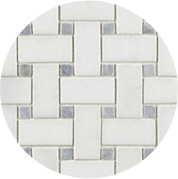Patterns and Types of Ceramic Tile

Ceramic Tile Flooring Patterns and Types
Once you’re ready to pick the ceramic tiles for your installation project, you have two types to choose from: unglazed and glazed. While unglazed tiles usually come in more styles than what is offered by glazed tiles, they are not always suitable for indoor installations. Taking a closer look at each tile type and their resultant costs can help you make an informed decision about which tiling is right for your installation project.
Unglazed Tiles
For outdoor ceramic tiling projects, there is no better choice than unglazed tiles which are extremely thick and durable. While very adept at resisting the stresses that come with being installed outside, unglazed ceramic tiles are generally not inherently stain resistant, and must undergo extra sealing to add this attribute. Unglazed tiles are more on the “exotic” side of the tile spectrum, and it’s cost is higher than average glazed tiles. Also, unglazed tiles require special preparation before installing, and that should be included in the cost estimate. Unglazed tiles come in a number of types and styles, some of the most popular of which include:
- Mexican Tile – Saltillo: True Saltillo styles are hand made in Mexico, giving an authentic, rugged appearance that is hard to match with any other tile type. Ease of care and a natural appearance are the biggest advantages of choosing Saltillo tile for your project. Although price can be influenced on the size and construction material of your Saltillo tile, the usual price range is a minimum of $1.50 and a maximum of $8.50 per square foot.
- Quarry Tiles: Similar in construction method to bricks, quarry tiles are a popular choice for homeowners looking for a high level of utility out of their tile choice. While vulnerable to excess moisture, quarry tiles are an exceptionally good choice for areas that experience high levels of foot traffic and everyday use. High quality quarry tiles usually cost about $2 to $5 per square foot.
- Encaustic Tiles: If you’ve ever seen a tile with intricate patterning, then you’ve seen an encaustic tile. Encaustic tiles use different colors of clay to produce unique, gorgeous patterning that can add a personal touch to your home. Due to their involved construction process, encaustic tiles have fallen somewhat out of favor in recent years. However, if you’re looking to maximize the aesthetic of your ceramic tile, encaustic tiles are a great choice. Encaustic tiles can range in cost depending on the quantity of tiles purchased, but usually cost roughly $7 to $9 per square foot.
- Ceramic Mosaic Tiles: Mosaic tiles are generally very small, less than two square inches, and are installed on a mesh sheet to form a coherent pattern. Mosaic tiling provides a classic look that is appealing to a wide range of homeowners. Owing to their ability to be highly customized, ceramic mosaic tiles have an extremely wide price range, with a minimum cost of $3 per square foot and a average cost of $25 dollars per square foot. Price can go up as $75 to $100 for handmade / exotic mosaic tile. If you have a specific tile design in mind, ceramic mosaic tiles are probably the right choice for your tiling project.
- Terra Cotta: The oldest form of tiling that exists, terra cotta tile is similar to Saltillo tiling in that it is made from clay or other earthen material. With its characteristic orange-brown coloring, terra cotta tiling is the tried and true choice for outdoor spaces the world over. The biggest advantage of terra cotta tiling, when made correctly, is that it has a longer lifespan than almost any other tile type. However, with modern terra cotta, there is no guarantee in material or construction quality. Terra cotta tiling can cost a minimum of $3 per square foot and a maximum of $7 per square foot.
Glazed Tiles
Glazed tiles are different from unglazed tiling thanks to their finish. Glazed tiles are usually coated with glass minerals or some sort of ceramic stain that gives them added water and stain resistance. Additionally, glazed tiles can come with a number of finishes that alter their appearance and texture. Because of the varieties in finishing and coating, glazed tiles have a massive price range, with the minimum of $1 and the maximum of $20 per square foot. Two of the most popular styles of glazed tiles are:
- Stone Look: Stone look glazed tiles are those that are constructed in a way that gives the appearance of natural stone tiling. The biggest advantage of stone look tiling is a matter of price, with glazed stone look tiling often costing a fraction of what you would pay for tiling actually made for stone. Price range is $0.65 to $9.50.
- Metallic Glazed: As you would expect, metallic glazed tiling is coated in such a way that it looks like actual metal tiling, usually attempting to take on the look and style of stainless steel. Similar to stone look glazed tiling, metallic glazed tiling is often much cheaper than the real deal, making this a great choice for homeowners who want the look of metallic tiling without the exorbitant cost. Price range is $0.7 to $10.5.
Ceramic Tile Sizes
Less a matter of cost and more a matter of style, ceramic tile can come in a number of sizes. Larger sizes of tile are particularly useful for opening a room up, as well as being much easier and less time consuming to install. The smaller the tile size that you choose, the longer the install time will be. However, smaller tiles often lend themselves to more intricate designs and can make a room feel more intimate and personal. When it comes to thickness, larger tiles sizes are usually thicker in order to add to their consistency and durability. You will almost never find any sort of tile that is over an inch thick. Although tiles sizes are very customizable, there are a few standard sizes that are popular with most homeowners:
- Typical thickness “⅜”
- 4’’ X 4’’ tile - most common
- 6” X 6” tile
- 12” X 12” tile
- 16” X 16” tile
Ceramic Tile Characteristics
Perhaps more than any other flooring type that you could choose for your home, ceramic tile offers a number of distinct advantages to you as a homeowner. In addition to the wide variety of styles and types discussed above, ceramic tiling possesses a number of characteristics that increases its lifespan and makes it a great choice for active homes. Some of the most important characteristics of ceramic tiling that you should be aware of include:
- Fire Resistance: The biggest advantage of choosing ceramic tiling for your home is its total resistance to fire. Ceramic tile will not burn at any temperature, nor will it serve as fuel during a house fire. Because of this heat and fire resistance, ceramic tiling is a popular choice for kitchens and other rooms that are fire risks.
- Water Resistance: Ceramic tiling, specifically glazed ceramic tiling is non-porous, meaning water will not absorb into the tiling. Any spills that you may have will not damage your tiling and will be easily cleaned.
- Moisture Resistance: Similar to water resistance, ceramic tiling is adept at resisting moisture build-up over time, which is one of the reasons it is such a popular choice for outdoor areas that are vulnerable to the elements.
- Stain Resistance: More than any other flooring type you could choose, ceramic tiling is almost completely stain resistant. While glazed tiling is the most stain resistant type, certain styles of unglazed tiling will also withstand most stain causing substances, maintaining its look and integrity well into the future.
- Scratch Resistance: When properly maintained and regularly cleaned, ceramic tiling is entirely scratch and abrasion resistant. It will hold up to even the most active home, usually keeping its original appearance decades into the future.
- Slip Resistance: Both glazed and unglazed ceramic tiling are slip resistant under most circumstances. Because they usually have a rougher texture, unglazed tiling is usually the better choice for areas of the home where slips are more likely, such as a bathroom or a kitchen.
- Easy to Install: Ceramic tiling, unlike like other flooring types such as hardwood, is extremely easy to install, often shortening the length of your project and reducing your labor costs.
- Easy to Clean: Because ceramic tiling resists liquid, stains and other materials, it is very simple to clean. In low traffic areas, ceramic tiling usually only needs periodic sweeping or mopping to maintain its usual appearance.
- Color Permanence: Unlike other common flooring options, ceramic tiling is not subject to color fading in most circumstances, retaining its normal appearance and coloring for its whole lifespan.
- Ceramic Floor Installation Cost Calculator
- Ceramic Cost
- Ceramic Tile Flooring Patterns and Types
- Ceramic Tile Grout Types
- Places Where Homeowners Can Install Ceramic Tiles
- Ceramic Tile Maintenance
- Where Homeowners Can Buy Materials
- Ceramic Floor Installation / Labor Cost
- To DIY or Not: Problems and Limits
- Contractor Hiring



Comments
Comments are disabled for this post